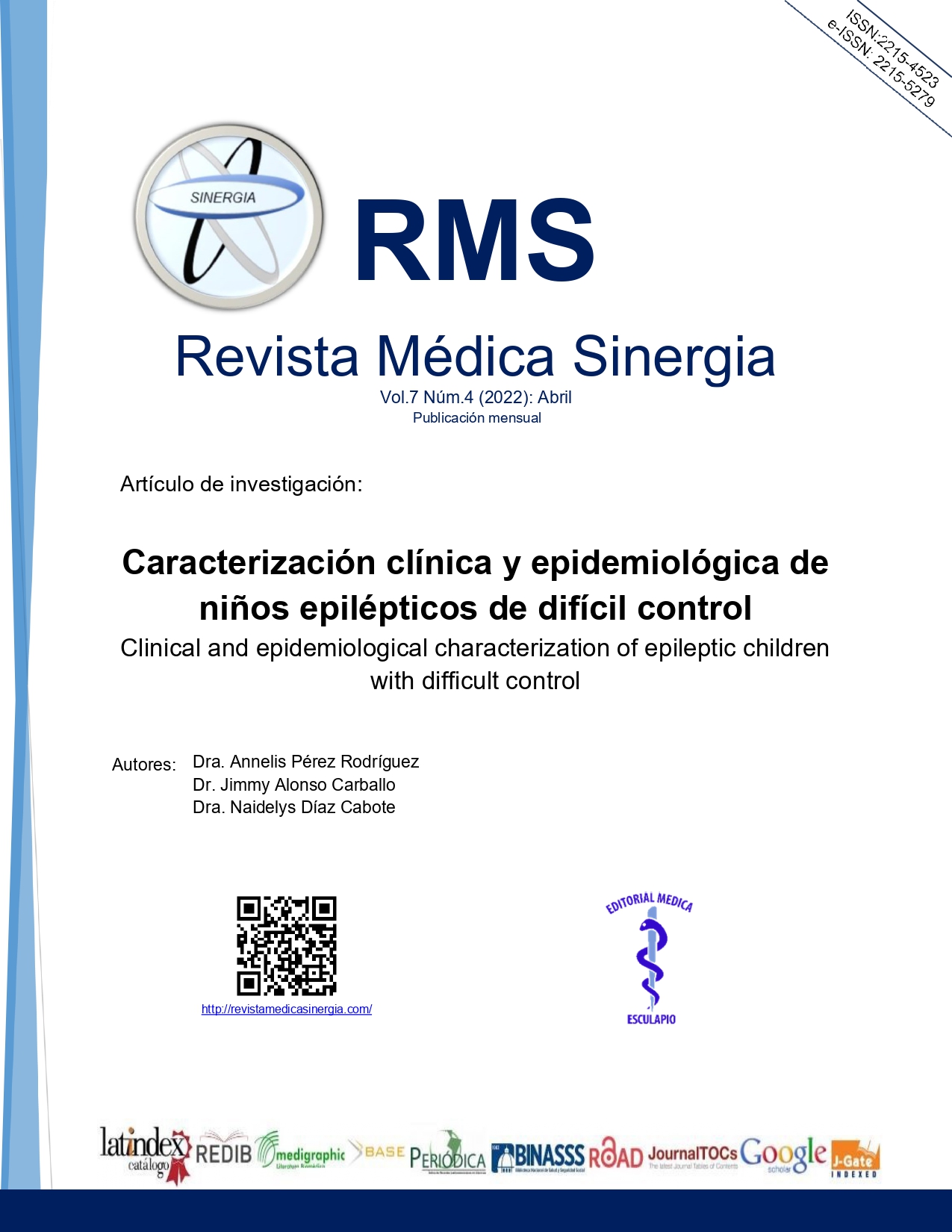Abstract
Introduction: Epilepsy is an alteration of the central nervous system due to an increase and abnormal synchronization of electrical activity, which can be manifested by recurrent, spontaneous, intense and unpredictable episodes. Objective: To characterize epileptic children who are difficult to control according to clinical, epidemiological and therapeutic aspects. Material and methods: A descriptive cross-sectional study was carried out with epileptic children of difficult control seen in the neuro-pediatric consultation of the outpatient center in the provincial pediatric hospital of Camagüey between September 2019 and February 2020. The sample consisted of 69 children. Behavior was evaluated by age, sex, age of onset, prenatal, perinatal and postnatal history, family history, type of seizure, electroencephalographic manifestations and drugs used. Results: Male sex prevailed in patients with difficult to-control epilepsy and the infant stage was the most represented in terms of age of onset. The most identified etiology was perinatal, with hypoxia prevailing at birth. Generalized seizures were the majority in these patients. The most widely used drug was sodium valproate, with the highest percentage of patients in the live controlled state. Conclusions: Males and the 6 to 9-year-old group were the most representative with a predominance of onset in lactation. Of the causal factors, perinatal and perinatal asphyxia were the most relevant, with generalized seizures being the most identified. Almost all of the patients presented electroencephalographic manifestations. The most commonly used drug was sodium valproate.
Keywords
References
Barreda Celis R, Suárez Moreno V, Timaná Ruiz R. Recomendaciones para el tratamiento de epilepsia resistente a fármacos 2016. [Internet] Disponible en: http://www.essalud.gob.pe/ietsi/pdfs/guias/Recomendaciones_para_el_Manejo_de_Epilepsia_refractaria.pdf
Ponce Pilozo MJ. Factores asociados a Epilepsia Refractaria Hospital Abel Gilbert Pontón, año 2018 [Internet]. 2019 Disponible en:
http://repositorio.ug.edu.ec/handle/redug/43458
Ocampo Ortega WM. Estudio del perfil Clínico Epidemiológico de los pacientes con Epilepsia en el área clínica del Hospital Metropolitano y Centro de Epilepsia Neurovida de la Ciudad de Quito durante el periodo de enero 2006 a diciembre del 2016. [Internet] 2018 Disponible en: http://repositorio.puce.edu.ec/bitstream/handle/22000/15537/TESIS.pdf?sequence=1&isAllowed=y
Melgarejo S. La nueva definición unificada de epilepsia refractaria favorece el estudio de estos pacientes. 2016 [Internet] Disponible en: http://neurologia.publicacionmedica.com/spip.php?article621
Ismayilova N, Leung MA, Kumar R, Smith M, Williams RE. Ketogenicdiettherapy in infantslessthantwoyears of ageformedicallyrefractoryepilepsy. Seizure [Internet]. 2018. Disponible en:
https://doi.org/10.1016/j.seizure.2018.02.014
Ismayilova N, Leung MA, Kumar R, Smith M, Williams RE. Ketogenicdiettherapy in infantslessthantwoyears of ageformedicallyrefractory epilepsy.2018 [Internet] Disponible en:
SariegoJamardo A, García Cazorla A, Artuch R, Castejón E, García Arenas D , Molero Luis M, Ormazábal A, Sanmartí FX. Efficacy of theKetogenicDietfortheTreatment of RefractoryChildhoodEpilepsy: Cerebrospinal Fluid Neurotransmittersand Amino AcidLevels. 2015 [Internet] Disponible en:
Arya R, Peariso K, GaínzaLein M, Harvey J, Bergin A, Brenton JN, et al.
Efficacy and safety of ketogenicdietfortreatment of pediatricconvulsive
refractory status epilepticus. Epilepsy Res [Internet]. 2018. Disponible en: https://doi.org/10.1016/j.eplepsyres.2018.04.012
Baby N, Vinayan KP, Pavithran N, Grace Roy A. A pragmaticstudyonefficacy, tolerability and longtermacceptance of ketogenicdiettherapy in 74 South Indianchildrenwithpharmacoresistantepilepsy. Seizure [Internet]. 2018 Disponible en: https://doi.org/10.1016/j.seizure.2018.03.020
Vehmeijer FOL, Van Der Louw EJTM, Arts WFM, Catsman-Berrevoets CE, Neuteboom RF. Can wepredictefficacy of theketogenicdiet in childrenwithrefractoryepilepsy? Eur J PaediatrNeurol [Internet]. 2015. Disponible en: http://dx.doi.org/10.1016/j.ejpn.2015.06.004
Gutiérrez Tirado N. Uso de la dieta cetogénica para el control de convulsiones en niños con epilepsia refractaria. [Internet]. 2019 Disponible en:
Sánchez Díaz T. En niños con epilepsia refractaria, ¿la dieta cetogénica reduce las crisis epilépticas? [Internet]. 2019 Disponible en: https://dspace.uib.es/xmlui/bitstream/handle/11201/152207/Sanchez_Diaz_Tamara.pdf?sequence=1&isAllowed=y
Crespo Díaz CM, Plaza Aguacondo EA. Calidad de Vida en pacientes pediátricos con epilepsia que van a consulta de Neurología Pediátrica en el Hospital de niños Dr. Roberto Gilbert desde el mes de septiembre de 2016 al mes de marzo del 2017. [Internet]. 2017 Disponible en: http://192.188.52.94/bitstream/3317/8079/1/T-UCSG-PRE-MED-579.pdf
Castro Resabala NA. Efectividad de la dieta cetogénica como tratamiento de la epilepsia refractaria en niños y adolescentes. [Internet]. 2019 Disponible en: http://hdl.handle.net/11201/150313
St. Louis EK, Cascino GD. Diagnosis of epilepsy and related episodic disorders. Continuum (Minneap Minn) 2016;22(1 Epilepsy):15-37. Palacio JM, Rojas K. Regulación del uso de cannabis en los niños argentinos con epilepsia refractaria. Una mirada desde el derecho latinoamericano comparado. [Internet]. 2019 Disponible en
https://revistas.ubp.edu.ar/index.php/rdys/article/view/61/49
Kwan Chang RS, WiliamLeung CY, Alvin Ho CC, Yung A Classifications of seizures and epilepsies, where are we? – A briefhistoricalreview and update. Journal of theFormosan Medical Association. [Internet]. 2019 Disponible en:
https://doi.org/10.1016/j.jfma.2017.06.001
Orozco Hernández JP, Quintero Moreno JF, Marín Medina DS, Castaño Montoya JP, Hernández Coral P, Pineda M. et al. Clinical and sociodemographicprofile of epilepsy in adultsfrom a reference centre in Colombia. Neurologia. [Internet]. 2016 Disponible en:
https://doi.org/10.1016/j.nrl.2017.02.013
Restrepo Gualteros SM, Milena S, Maria A. Semiología de la crisis epiléptica: un reto clínico. [Internet]. 2016 Disponible en:
https://doi.org/10.1016/j.reper.2016.06.002
Velez, A, Eslava Cobos J. Epilepsy in Colombia: Epidemiologicprofile and classification of epilepticseizures and syndromes. Epilepsia. [Internet]. 2016 Disponible en: https://doi.org/10.1111/j.1528-1167.2006.00387.x
Pico Fonseca SM. Tratamiento nutricional con dieta cetogénica en niños con epilepsia refractaria - revisión narrativa. [Internet]. 2020 Disponible en:http://199.89.53.2/index.php/nutricionclinicametabolismo/article/view/10/299
Shek-kwan Chang R, Chun Yin WL, Chi Chung AH, Yung A. Classifications of seizures and epilepsies, where are we? A brief historical review and update. Formos Med Assoc. 2017;116:736-41. Doi: 10.1016/j.jfma.2017.06.001
Siedlecka M., Grajkowska W., Galus R., Dembowska-Bagiska B., J??wiak J. Focal cortical dysplasia: Molecular disturbances and clinicopathological classification (Review). Int J Mol Med. 2016:1327-37, doi: 10.3892/ijmm.2016.2760.
Jin B., Wang J., Zhou J., Wang S., Guan Y., Chen S. A longitudinal study of surgical outcome of pharmacoresistant epilepsy caused by focal cortical dysplasia. J Neurol. 2016;263(12):2403-10, doi: 10.1007/s00415-016-8274-1.
Yao K., Duan Z., Zhou J., Li L., Zhai F., Dong Y., et al. Clinical and immunohistochemical characteristics of type II and type I focal cortical dysplasia. Oncotarget. 2016, doi: 10.18632/oncotarget.13001.
Bosak M, Słowik A, Kacorzyk R, Turaj W. Implementation of the new ILAE classification of epilepsies into clinical practice - A cohort study. Epilepsy Behav. 2019;96:28.
Trinka E, Kälviäinen R. 25 years of advances in the definition, classification and treatment of status epilepticus. Seizure. 2017 [citado: 12/12/2019];44:65-73. Doi: 10.1016/j.seizure.2016.11.001

This work is licensed under a Creative Commons Attribution-NonCommercial 4.0 International License.
Copyright (c) 2022 Array


